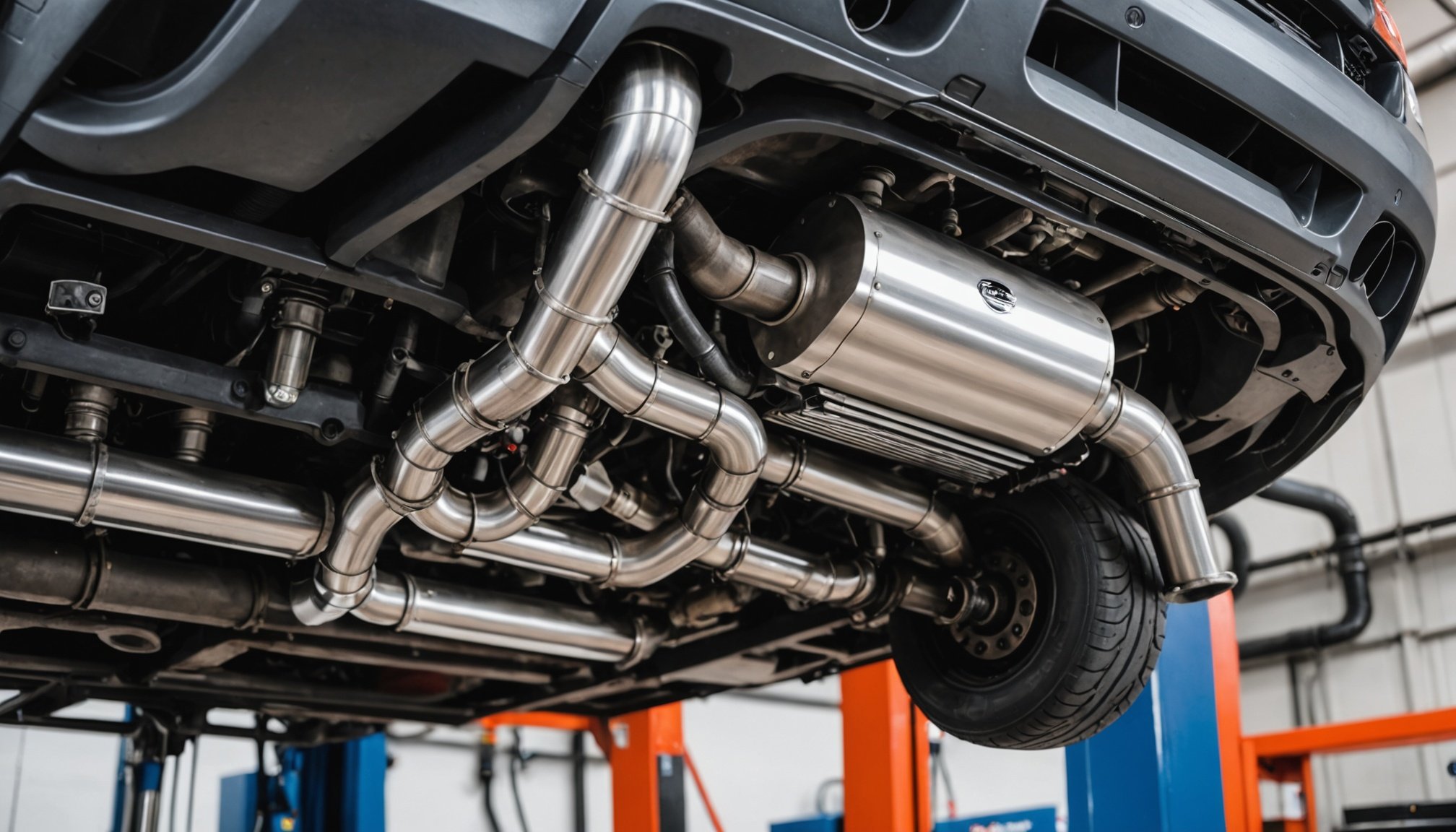Understanding Exhaust Systems
When considering an exhaust system upgrade, the type of exhaust system you choose can greatly impact your vehicle’s performance. Generally, exhaust systems fall into categories, such as:
- Cat-back – extends from the catalytic converter to the exhaust outlet.
- Axle-back – replaces components from the rear axle to the tip.
- Header-back – involves a complete system replacement from the engine’s exhaust header.
These systems are crucial as they manage emissions, reduce noise, and influence the engine’s breathing efficiency, thereby enhancing vehicle performance.
Also to read : Ultimate guide to enhancing high-speed handling: installing a steering dampener for thrilling uk track experiences
Exhaust upgrades can notably improve engine performance by optimising airflow and reducing back pressure. This allows the engine to release exhaust gases more efficiently, leading to heightened power output and fuel efficiency. Such modifications are popular among enthusiasts looking to elevate their vehicle’s capabilities.
However, it’s paramount to be aware of UK regulations concerning exhaust modifications. UK law stipulates specific noise level restrictions and emissions standards that must be adhered to, ensuring that modifications do not adversely affect the environment or public peace. Before implementing an upgrade, it’s essential to verify that your changes comply with these regulations to avoid penalties.
Selecting the Right Exhaust System
Choosing the right exhaust components requires careful consideration of several factors to ensure compatibility and performance enhancements. Let’s explore how to analyze your vehicle’s specific needs and the various types of exhaust systems available.
Evaluating Your Vehicle’s Needs
When selecting exhaust components, first evaluate your vehicle’s requirements, such as its type and intended use. Consider factors like horsepower and torque improvements, which are essential for enhancing performance. Understanding these needs will help you make informed decisions, ensuring the compatibility and effectiveness of new components.
Different Types of Exhaust Systems
Exhaust systems come in various configurations, each offering unique benefits. The three primary types include:
- Cat-back systems: Replace the exhaust system from the catalytic converter to the exhaust tip, offering improved performance and sound.
- Axle-back systems: Modify the exhaust components located behind the rear axle, typically the least expensive and easiest to install.
- Header systems: Replace the exhaust manifold, providing the most substantial performance increase by enhancing exhaust flow.
Compatibility with Existing Parts
Ensuring compatibility with existing components is crucial. Mismatched parts can lead to performance issues and decreased efficiency. Understanding your current setup and desired improvements will guide you in choosing components that align with the vehicle’s architecture, maintaining optimal functionality.
Installation Process for Exhaust Systems
Understanding exhaust installation is crucial for car enthusiasts and DIYers eager to take on the task themselves. Whether choosing the DIY route or opting for professional services, knowing what the process entails is key.
Step-by-step DIY Installation
To start a DIY exhaust installation, ensure you have the right tools needed. Essential tools include a wrench set, socket wrench, and jack stands. Firstly, safely elevate the vehicle using jack stands, ensuring stability. Next, remove the old exhaust by unscrewing the fasteners and carefully lowering it. Align the new exhaust system, ensuring a snug fit at each connection point. Secure the system by tightening all bolts and confirm there are no loose parts that could cause an issue later.
DIY vs Professional Services
While DIY installations can be rewarding, consider professional installation services if you’re unsure. Professional installers offer expertise, guaranteeing that the job conforms to industry standards, which is especially critical for high-performance exhaust systems that require precision to function optimally.
Tools and Safety Equipment
In addition to basic tools needed, always utilize safety equipment when working under your vehicle. Safety goggles, gloves, and sturdy footwear will protect against potential hazards. Remember, an informed decision on pursuing a DIY or professional installation will depend on your comfort with the technical demands and available resources.
Performance Benefits of Upgrading
Upgrading your vehicle’s exhaust system can significantly enhance performance and bring multiple benefits. One of the primary gains is in horsepower and throttle response. When you replace a restrictive stock exhaust with a performance system, it allows for a more efficient flow of exhaust gases. This increase in flow rate generally results in higher horsepower, giving your engine that extra kick.
Fuel Efficiency
Another advantage of a performance exhaust system is improved fuel efficiency. By enhancing the exhaust flow, the engine doesn’t have to work as hard. This optimized performance can lead to better fuel consumption rates, making it an appealing choice for both daily commuting and long-distance travel.
Sound Improvement
For many enthusiasts, the most exhilarating benefit is the sound improvement. Performance exhausts alter your vehicle’s sound profile, offering a richer and more aggressive tone. Whether you’re aiming for a deeper growl or a high-pitched roar, the choice of exhaust system can dramatically impact the auditory experience of your drive.
Considering these factors, upgrading your exhaust system is not just about aesthetics but achieving a harmonious balance of power, efficiency, and sound. It’s an investment in transforming the driving experience into something truly exceptional.
Compliance with UK Regulations
Navigating the landscape of UK exhaust regulations is crucial for vehicle owners. The legal requirements dictate that exhaust systems must meet specific standards to minimise environmental impact and ensure safety. These standards include restrictions on emissions levels and noise, as established by governmental bodies.
Compliance checks are an essential step post-installation, ensuring that the exhaust system functions within legal parameters. Authorised testers assess emissions output and sound levels, ensuring no deviation from the stipulated thresholds. Regular checks can prevent potential issues and maintain vehicle efficiency.
The importance of adhering to these regulations extends beyond legal obligations. Non-compliance can result in significant consequences, including hefty fines and potential vehicle impoundment. Moreover, failure to comply with legal requirements may lead to increased insurance premiums or invalidation of insurance policies. To avoid such pitfalls, vehicle owners should ensure their exhaust systems are compliant and well-maintained.
Owners can avoid violations by staying informed about changes in UK exhaust regulations and promptly addressing any issues identified during compliance checks. This proactive approach not only conserves the environment but also protects the owner from legal repercussions. Regular maintenance and awareness are key to maintaining a compliant vehicle.
Cost Considerations
When considering exhaust system costs, recognizing the breakdown is crucial. Assess your options: standard replacement exhausts typically involve lower expenses than performance upgrades. These costs not only include the exhaust parts themselves, but also labour charges for installation, which can vary significantly based on complexity and vehicle type.
Budget planning demands attention to both parts and labour. Start by determining what your vehicle requires and research trusted manufacturers for part prices. Next, get quotes from various mechanics for installation fees. Transparency in budgeting ensures no last-minute financial surprises, also allowing room for potential future adjustments or repairs.
Evaluating the long-term value is vital. While upgraded exhaust systems might come with a higher initial investment, they often offer benefits like enhanced vehicle performance, improved fuel efficiency, and longer lifespan. This can translate to savings over time, balancing out the initial cost.
Here are steps to streamline your evaluation:
- Compare the immediate costs with predicted benefits.
- Consider potential resale value increase for your vehicle.
- Weigh the environmental benefits, which may offer economic advantages.
In essence, integrating exhaust system costs into your broader financial plan involves careful consideration of multiple factors, ensuring both immediate and future satisfaction with your investment.
Maintenance Tips for Exhaust Systems
Keeping your exhaust system in peak condition is essential for the longevity and performance of your vehicle. Regular exhaust maintenance involves a few critical tasks that are often overlooked. First, routinely inspect your system for visible damage, such as rust or holes, which can hinder performance upkeep and may indicate the need for repairs. Listen for unusual noises, like rattling or hissing, which often reveal leaks or loose components.
To ensure your upgraded exhaust system continues to deliver optimal performance, follow these quick tips:
- Clean components regularly. Use a soft cloth and a mild soapy solution to remove dirt and grime, which helps prevent corrosion.
- Visit a professional service for a thorough inspection at regular intervals. Qualified mechanics can spot potential issues before they escalate, ensuring optimal function.
- Monitor the longevity of parts. Be vigilant for signs like decreased fuel efficiency or power loss, which suggest system deterioration.
Understanding and responding promptly to warning signs can significantly enhance the lifespan of your exhaust system. Adhering to these tips should provide reliable performance upkeep, making your driving experience smoother and ensuring your vehicle stays on the road longer.











